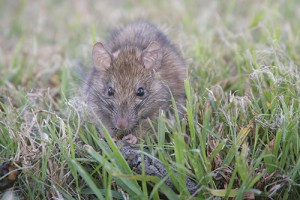
The roof rat requires a daily intake of about 0.5 oz. of water and 0.5 oz. of food . Photo copyrighted by photographer177 / www.fotosearch.com
Whether by roof, burrow or sewer, attacks by roof rats (aka black rats and ship rats) cause poor public heath and economic damage to food commodities, landscapes and structures.
LIFE CYCLE: Survives nine to 12 months in the wild; averages 5 litters per year, with four to eight pups per litter.
DESCRIPTION: A sleek, smooth coat that is charcoal grey, black or light brown on top and cream or white along the underside. With eyes larger than Norway rats’, roof rats have a pointed snout, a body weighing 5 to 10 oz., and measure 13 to 18 in. nose to tail. The prehensile tail is scaly and longer than the rest of the body.
HABITAT: Commensally near available water and food within and around structures. The roof rat prefers upper floors and roof systems. Additionally, it’s capable of burrow construction and using tree hollows for colonial nests.
FORAGING: Expressing flexibility through foraging behavior, roof rats are predatory and readily adapt to robust microhabitats. With proximity between sexes, rats often forage in groups and after sunset. If not consumed quickly, food will be saved and eaten later. Although roof rats are capable omnivores, they can be selective feeders. If roof rat populations are faced with food diversity, they sample from what’s available. This enables consistent, dynamic, high-end nutrition. Foraging behavior determines meal composition.
FOOD: Roof rats require a daily intake of about 0.5 oz. of water and 0.5 oz. of food. They exploit almost any human food source. Their preference is for seeds, stems, fruits, fungi and both invertebrates and vertebrates.
RANGE: Ubiquitous. Can show up anywhere there are human inhabitants.
SIGNIFICANCE: Roof rats have successfully resisted all attempts to eradicate them. With astonishing adaptability, these animals possess high-end fecundity, acute sensory abilities (touch, hearing, smell and taste), and amazing physical agility. Rats inflict societal costs of human misery and financial loss.
Dr. Stuart Mitchell, D.O., Ph.D., M.P.H., B.C.E., a board-certified physician and entomologist, is principal technical specialist for PestWest Environmental, as well as PMP’s Technical Editor. He can be reached at docmitchell@northcoastmedia.net or 515-333-8923.
Leave A Comment